
To Pee, or not to Pee? A linguistic landscape analysis of toilet signs in the public sphere
Imagine sitting in a restaurant with friends. You are having a great night. Suddenly you have the urge to go to the bathroom, so you ask the waiter where the toilets are. Once you arrive there, you are faced with a dilemma. Which door do you choose? The signs on the door are not immediately clear and you cannot instantly distinguish between the men’s and women’s toilets, because of the weird and unclear signs. Does this sound like a familiar situation? Yes? Then you are not alone. Toilet signs often display images related to gender norms, genitalia, or language to distinguish between women’s and men’s toilets. This can cause confusion among users of these toilets.
In this article, we will examine six different pictures of toilet signs in public spaces. We have found these pictures on the internet. They are intended to be an original alternative to regular toilet signs. With this research, we attempted to point out how these original and 'updated' toilet signs are in fact outdated and often misrepresentative. The focus of this article lies on how these signs lose their humorous aspects when viewed by non-cis-gendered people and instead become a reflection of offensive and distressing linguistics. For some of the pictures, the location of the toilet signs is not clear. When a location is known, it will be mentioned.
Methodology
For this research, we conducted a survey where members of the transgender community were asked whether they found toilet signs uncomfortable or offensive and whether they would have trouble choosing between the women’s and men’s toilets. The survey was conducted online and shared in several Facebook groups for transgender people, mainly via snowballing. The survey was initially sent to a single individual, who then shared it in the private Facebook group that served as a support group for transgender individuals. It received 75 responses, of which 44 respondents identified as “man”, 14 identified as “woman”, and 16 as “other”. This was a vastly higher amount of respondents than we had anticipated at the start. Although this number of respondents might not offer a cross-section of the opinions held by transgender people, the survey does offer insight into the qualitative responses of a select number of trans individuals. The toilet signs have been divided into three sub-categories, namely genitalia, gender norms, and language. Signs can fall into multiple of these sub-categories.
The survey presented respondents with images of toilet signs and asked which of the two doors they would choose. Then, they were asked whether it was hard to decide which door to choose, and why this was the case or not. Finally, for each image, respondents were asked if the signage appeared offensive, and whether they felt uncomfortable about the implications behind the signs.
To analyze this survey, we will utilize the analytical framework of ELLA (Linguistic Landscape Studies) (Blommaert & Maly, 2016), as we examine the three perspectives or “arrows” of the signs: backward, forwards, and sideways. The backward arrow indicates the goal with which the sign is produced. The sideways arrow covers the placement of the sign in a public space. The forwards arrow is concerned with the uptake of the sign, and how it is received in its context.
The arrows in question are the arrows of Indexicality. The backward arrow refers to the past of the sign, such as the condition of the production and (possible) historic context. The forward arrow indicates the future of the sign, such as those addressed by it, and the conditions for understanding it. Lastly, the sideways arrow points to the present, location and placement of the sign (Blommaert & Maly, 2016).
This framework was established with the goal of identifying and analyzing signs and pieces of language in public spaces. It can be useful to determine which languages are prevalent in which spaces, and how extensively these languages as well as certain images and signs are used. The main focus of our analysis is on the use and focus of language, gender norms, and genitalia in the signs.
The “Funny” Toilet Signs
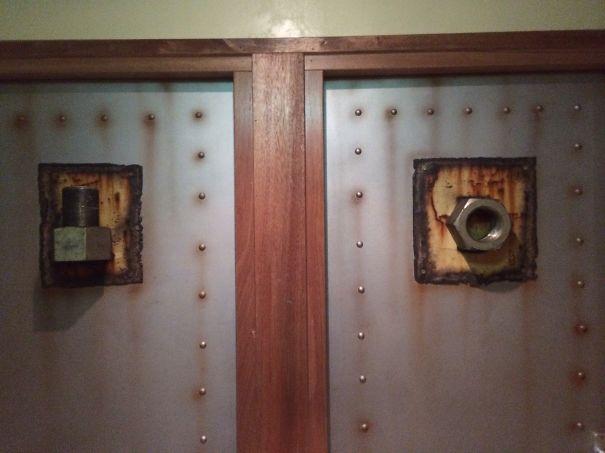
Figure 1: Screw and Nut
The toilet signs in Figure 1 are depicted in a pub called Toxbar. This pub is located in Schiermonnikoog, The Netherlands. The signs are focused purely on the genitalia of men and women. The screw (left) is supposed to resemble the penis, therefore indicating the men’s bathroom and the women’s bathroom is indicated by the nut (right), which is supposed to resemble the vagina. Although it may be confusing for some at first, once one has figured out these signs they are quite straightforward. Especially since these signs are universal.
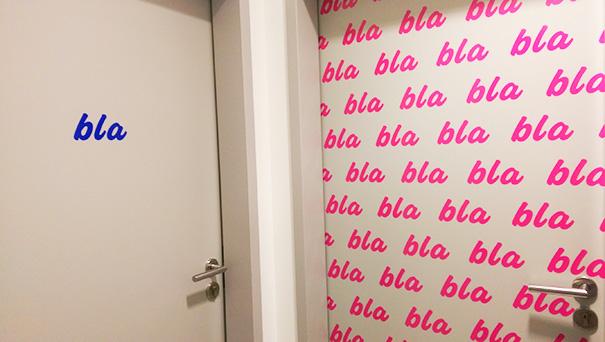
Figure 2: Blabla
In Figure 2 two doors for toilets can be seen. These doors can be found in an unknown restaurant in Germany. One of the doors contains a blue word; “bla”. The other one contains multiple pink “bla’s”, the whole door is covered with it. It can be argued that the door on the right is for women since pink is seen as a feminine color, while blue is seen as a more masculine color. Another argument is how talking a lot is a stereotype generally used to describe women, whereas it is more of a gender norm for men to talk less than women. In terms of language, onomatopoeia is used, a universal word, namely “bla”. It is a term that everybody recognizes and can understand.
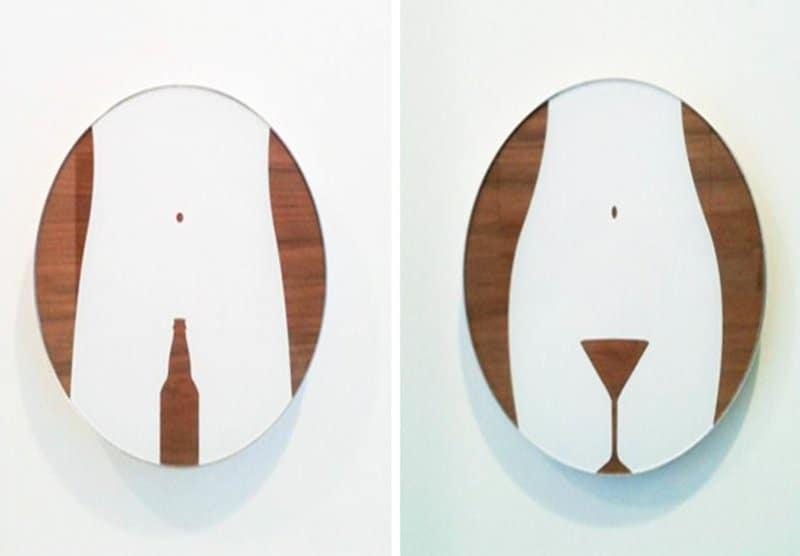
Figure 3: Drink preference
Next, we have the toilet signs in Figure 3. The location of these signs is unknown. Whereas our previous two figures played into either genitalia or gender norms, figure 3 manages to combine the two in a, it has to be said, clever visual manifestation. They make use of what is called a ‘Gestalt switch’. This is when one can see two different shapes in a picture, depending on what part they focus on. When focusing on the white, one can see a classic male shape on the left and a classic female shape on the right. The dark brown spaces in the place where normally the genitalia would be, consequently add to the distinction between the two toilets. The penis is replaced with a beer bottle, which both resembles the penis in shape and is seen as a masculine drink, therefore indicating that this is the men’s toilet. The same is done with the cocktail class mimicking the shape of the vagina, since cocktails are seen as a more feminine drink, marking it as the female bathroom. Thus, the signs play into both genitalia and gender norms, which, to top it all off, are both universal.
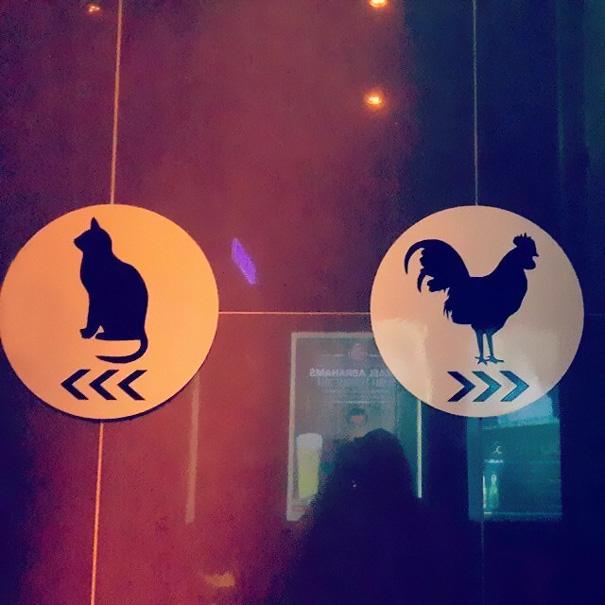
Figure 4: Cat and Rooster
The location of the toilet signs in Figure 4 is unknown. Figure 4 once more combines two aspects of gender distinction. This is also arguably the least straightforward so far; because it relies on the audience to be English speakers, as the two signs resemble two slang terms for genitalia. On the left we have a “pussy”, for the women, and on the right a “cock” for the men. It thus combines the aspect of language with that of genitalia, though this time not in a universal manner. Let us hope the venue that put up these signs is exclusively visited by people with a good grasp of English, otherwise, they could lead to some awkward situations!
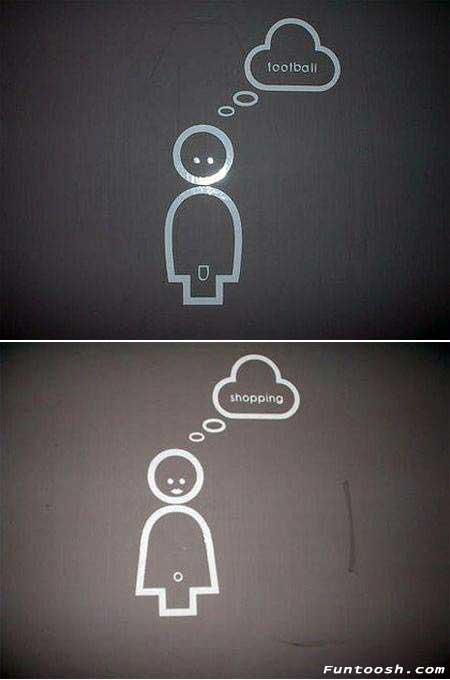
Figure 5: Football and Shopping
Moving away from signs focusing on genitalia, we see another example of signs that rely on the audience to read English. These signs can be found in one of the PentaHotels in the United Kingdom. Although the words used in Figure 5 are slightly more common and simple than the references in Figure 4. It does, however, on top of the language aspect, play into gender norms as well. The illustrations are very similar, with the largest difference coming in the form of the word in the thought bubble. The top one shows a person thinking about football, a hobby seen as masculine, thus this indicates the men’s bathroom. The women’s bathroom is indicated with a person thinking about shopping, a hobby considered to be feminine. Possibly simpler than the previous figure, but also more stereotypical.
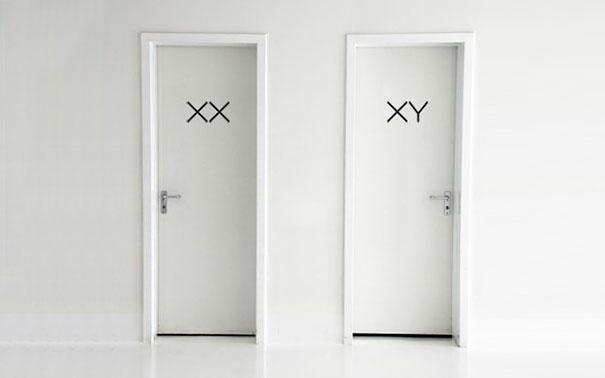
Figure 6: XX and XY Chromosomes
This last set of toilet doors in Figure 6 provides the most bewildering imagery. The location of these signs is unknown. In order to be able to choose the ‘correct’ toilet door, one would not only need to know what XX and XY refer to but also how they apply to humans. XX and XY are the sets of sex chromosomes in human DNA that determine our biological sex, in typical medical cases. A single pair of chromosomes out of 23 total pairs determines our birth sex. This is typically taught in high school biology classes. However, a large majority of the people who use these bathrooms will not remember what XX and XY refer to; nor will they know what door to pick based on their sex. XX is for the female sex, and XY is for the male sex. There is also the issue of chromosomal abnormalities, where one would not match to either of the possibilities. They are technically a universal term, as chromosomes are globally recognized in science after all. These signs are overcomplicated and could cause confusion among the general population.
A different view on toilet signs
Generally, people did not have much trouble choosing, rather they were uncomfortable or offended. Those who were unsure of whether or not they would pass as one gender or the other tended to choose their outward presenting gender over their gender identity. Gender dysphoria caused a lot of discomfort when choosing a bathroom. The context in which the signs were placed, for example, if the signs were in a club or not, was highly important to the level of comfort or offensiveness related to the signs. There was a general response of people being offended about gender being boiled down to genitalia or in the case of Figure 6 even reduced to DNA.
Gender norms and stereotypes were often noted or pointed out, and were said to be varyingly offensive. Figure 2, with behavioral stereotypes, was not seen as overtly offensive, as opposed to Figure 5, which contained hobby stereotypes. Apparently, the topic of stereotyping does make a difference in the degrees of offense it brings out in people. When presented with a choice between two gender norms, people opted for their personal preference in regard to the stereotype, such as choosing the color they favored, their drink of choice, or the activity they preferred.
There was a lot of confusion regarding Figure 4, as you need a decent grasp of English, in particular the nuances of the language and its slang, to decipher the message. Alongside figures 2 and 5 these three signs require the users to understand the linguistic reference. Figure 2 is the only sign containing onomatopoeia, with "bla" being universally understood. Figures 4 and 5 require an understanding of English. Survey respondents mentioned in particular that they did not understand the implication in figure 4, or used a different thought process than was expected. A respondent argued the traditionally feminine and masculine associations with both animals, with felines being seen as feminine creatures. They eventually came to the conclusion that was intended, but not in the way the maker had intended.
As mentioned above, several images induced gender dysphoria amongst respondents. A person who experiences gender dysphoria is uneasy because their biological gender does not match their gender identity (NHS, 2020). Four of the signs chosen were linked to male and female genitalia, and the respondents generally did know which one they were supposed to choose. For Figure 1 there was a division between people who understood the implications of the image made. The screw goes in the nut, so screw means penis, and nut means vagina. Others did not notice or did not understand the reference to screws. It was also noted with several of these signs that explaining them to children would be rather tedious and inappropriate. Figure 3 did not spark the same confusion as respondents frequently went with their preferred drink instead. There was an outcry about equating gender to genitalia, which is seen as a very outdated concept, and the relation to the need to pee was questioned. Some respondents mentioned that their genitalia was not of relevance when using the toilet, at least not for the general public.
Figure 6 as opposed to all other images was taken far more seriously, as it went beyond superficial observations. Respondents mentioned the lack of inclusion of LGBTQ+ and particularly intersex people and expressed their offense about this. All other images were at least funny to some, but Figure 6 had no such funny responses. Chromosomal makeup, or karyotype, is not common knowledge and sparked a lot of confusion. A comment made was that they wanted someone who looked very masculine to walk into XX bathroom, as it directly defies what the signs intended with the traditional biological categorization.
“I kind of like the idea of trans men who are huge and lumberjack-ish going in the xx door just to throw people's ciscentric perceptions off” (Anonymous)
Contrary to the responses to the survey, which were mainly answered by non-cisgender people, general replies are mostly humorous. Most of the images discussed have been found through lists such as ‘10 Hilarious And Witty Restroom Signs’. When looking through the responses to these lists, most people find these signs funny, or do not entirely understand them, but can see the humor in them. This seems to indicate that the response to the toilet signs is heavily dependent on gender identity. The content is not found to be offensive or discomforting. There were responses saying that the signs were creative and that we should not feel offended by art. Respondents of the survey occasionally found a sign funny, but these voices were largely drowned out by the offense.
With the conducted data we concluded that these signs are based on (occasionally outdated) stereotypes and binary understandings of gender identity, and often have a less-than-intended effect on those who they are aimed at. If someone prefers leaving an establishment over relieving themselves is a clear indicator of the wrongness of some of these signs, and how simple bathroom signs can hold so much power over our emotions.
Exclusion in toilet signs
Now that all the data has been analyzed and our conclusions drawn, it is time to reflect. Of the three arrows, two could be covered right at the start of our analysis. All these signs were produced with the same goal of being original alternatives to regular toilet signs. All of them were also placed in public places, where they were photographed and shared online. Therefore, they shared a common backward and sideways arrow that was part of our LLA analysis. The bulk of this article, therefore, covered the remaining arrow, that of context, audience, and uptake.
The survey showed that context was an important factor in whether a sign was considered appropriate or offensive. For example, figure 6 offended people due to the fact it had a scientific connotation and was very binary and exclusive.
We also focused on three factors concerning toilet signs; genitalia, gender norms, and language. The use of genitalia was also quite binary and exclusive. This duality of choice was slightly confusing to some, but mostly just offensive. The language mostly attempted to add a comedic element, and the survey results confirmed that this goal was a least to an extent achieved. Gender norms were also used as a distinguishing factor. Interesting to note is that the stereotyping around gender norms was found to be more offensive when concerning hobbies (figure 5) than behavior (figure 2).
To conclude, the toilet signs were occasionally found to be funny but more prevalently considered offensive. Therefore, if one were to try and design an alternative and humorous toilet sign, here is a tip: Maybe also include people outside of the binary genders.
References
A. (2016, March 22). 20 Most Creative Bathroom Sign Designs. Demilked.
Gabulaitė, V. (2019, January 3). 102 Of The Most Creative Bathroom Signs Ever. Bored Panda.
Blommaert, J. & Maly, I. (2016). Ethnographic linguistic landscape analysis and social change: A case study. In: Karel Arnaut et al (Eds.), Language and superdiversity. New York//London, Routledge (p.197-217).
Julie Linley on. (2016, January 29). [@Midsummerchef love these]. Twitter.
Most Creative & Funny Toilet Signs. (2012, January 17). 1 Design Per Day.
NHS website. (2020, November 16). Gender dysphoria. Nhs.Uk.
Poonja, R. (2016, March 22). 10 Hilarious And Witty Restroom Signs. LOLWOT.